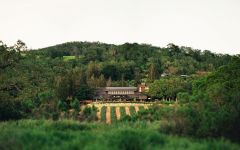Joseph Phelps Cabernet Sauvignon 2017
-
James
Suckling -
Wine
Enthusiast - Decanter
-
Wine
Spectator -
Robert
Parker -
Wilfred
Wong -
Jeb
Dunnuck -
Connoisseurs'
Guide



Product Details
Your Rating
Somm Note
Winemaker Notes
The 2017 Cabernet Sauvignon has expressive aromatics of blueberry, boysenberry, baking spices and cardamom. A fresh and inviting wine with unfolding layers of raspberry, red cherry, nutmeg, cedar and graphite with a medium-full body, seamless integrated tannins and a lengthy finish.
Blend: 92% Cabernet Sauvignon, 6% Malbec, 1% Petit Verdot and 1% Cabernet Franc
Professional Ratings
-
James Suckling
Very aromatic with blueberries and blackcurrants, as well as red licorice. Floral, too. Medium-to full-bodied, firm and lightly chewy. Lovely depth of fruit here. Rich and flavorful. Extremely well done for the vintage. Shows more finesse and tightness than 2016. Very classic. One-third of the production. Try it. Drink after 2022, but already delicious.
-
Wine Enthusiast
This is a beautiful wine, effusive in cassis, black cherry, woody cedar and sage. With small amounts of Malbec, Cabernet Franc and Petit Verdot, it offers substantial structure and tannin weight, with ample clove spice and toasted oak. It is built to age; enjoy best from 2025 to 2030.
-
Decanter
Packed with both charm and character with a powerfully spicy punch. Clear espresso flavours alongside mocha, grilled sarments, cassis and smoked bilberries. There are confident, ripped tannins also showing a muscular structure that is going to go the distance. Blend completed with 1% Cabernet Franc, aged in 48% new oak. Second vintage on the Place. Drinking Window 2022 - 2038
-
Wine Spectator
Offers a chunky feel, featuring a mix of dark plum and black currant fruit, with singed mesquite, dried bay leaf, sage and licorice root notes. Shows youthful rambunctiousness, balanced by good underlying structure and ample fruit. Should resolve easily with cellaring. Best from 2022 through 2034.
-
Robert Parker's Wine Advocate
This 2017 is a blend of 92% Cabernet Sauvignon, 1% Petit Verdot, 6% Malbec and 1% Cabernet Franc, with most of the fruit coming from Phelp’s St Helena vineyard this year. “But,” winemaker Ashley Hepworth told me, “we declassified a lot of wine - sold a lot on the bulk market. We had some tough blending decisions.” Deep garnet-purple in color, the 2017 Cabernet Sauvignon sashays out of the glass with open-knit, alluring baked plums, stewed cherries, mulberries and warm cassis with hints of spice cake, cracked pepper and tobacco leaf. Medium to full-bodied, the palate delivers a great intensity of black berry and exotic spice layers, framed by soft tannins and lively freshness, finishing with impressive length.
-
Wilfred Wong of Wine.com
COMMENTARY: The 2017 Joseph Phelps Cabernet Sauvignon is a delicious and proper Napa Valley Cab. TASTING NOTES: This wine defines the category Napa Valley Cabernet. Its pointedly attractive aromas and flavors of black fruit and leather coupled with its firm palate make it a natural with grilled beef. (Tasted: February 20, 2020, St. Helena, CA)
-
Jeb Dunnuck
The only wine here that has a touch of grower fruit, the 2017 Cabernet Sauvignon Napa Valley saw a two-thirds reduction in production due to declassifying due to smoke taint. It has a classic Cabernet nose of blackcurrants, scorched earth, tobacco, and lead pencil as well as a medium-bodied, supple, elegant, pretty style on the palate. Drink it over the coming 10-15 years.
-
Connoisseurs' Guide
Dark, very deep, solidly fruity and complex all at once, the latest from Joseph Phelps is a keenly focused Cabernet of measured richness that never overplays its hand. It smells and tastes of optimally ripened black cherries and currants with teasing touches of graphite, dried herbs and dusty soil and lightly laid-on creamy oak. Its combination of richness, careful crafting and structured solidity make it easy to appreciate now, but only with a few years will it come fully into its own, and it can be counted on to age gracefully for another six to eight.
Other Vintages
2021-
James
Suckling -
Wine
Enthusiast -
Robert
Parker -
Wine
Spectator -
Jeb
Dunnuck
-
Wine
Enthusiast -
James
Suckling -
Jeb
Dunnuck -
Wilfred
Wong -
Robert
Parker -
Wine
Spectator -
Wine &
Spirits
-
James
Suckling -
Wine
Spectator -
Jeb
Dunnuck -
Wilfred
Wong -
Robert
Parker -
Connoisseurs'
Guide
-
James
Suckling -
Wilfred
Wong -
Wine
Enthusiast -
Robert
Parker - Decanter
-
Jeb
Dunnuck
-
James
Suckling -
Jeb
Dunnuck -
Robert
Parker -
Wine
Enthusiast
-
Wine
Enthusiast -
Wilfred
Wong -
James
Suckling -
Robert
Parker
- Decanter
-
James
Suckling -
Robert
Parker
-
Wine
Enthusiast
- Decanter
-
Wine
Enthusiast
-
Wine
Enthusiast -
Robert
Parker
-
James
Suckling -
Robert
Parker
-
Robert
Parker -
Wine
Spectator
-
Wine
Enthusiast -
Wine &
Spirits
-
Connoisseurs'
Guide
-
Wine
Enthusiast
-
Wine
Spectator -
Robert
Parker
-
Wine &
Spirits
-
Wine
Enthusiast
-
Wine
Spectator
-
Wine
Enthusiast
-
Robert
Parker






Joseph Phelps Vineyards is a family-owned winery committed to crafting world class, estate-grown wines. Founded in 1973 when Joe Phelps purchased a former cattle ranch near St. Helena in the Napa Valley, the winery now controls and farms nearly 375 acres of vines on eight estate vineyards in St. Helena, the Stags Leap District, Oakville, Rutherford, Oak Knoll District, Carneros and South Napa Valley. In 1999, the Phelps family added 100 acres of vineyard property near the town of Freestone on the Sonoma Coast, where Phelps now grows Pinot Noir and Chardonnay.
Phelps is best known for its flagship Napa Valley blend of red Bordeaux varietals, Insignia, first produced in 1974. Awarded Wine Spectator's "Wine of the Year" in 2005, Insignia is widely regarded as a qualitative benchmark for California winemaking.

One of the most prestigious wines of the world capable of great power and grace, Napa Valley Cabernet is a leading force in the world of fine, famous, collectible red wine. Today the Napa Valley and Cabernet Sauvignon are so intrinsically linked that it is difficult to discuss one without the other. But it wasn’t until the 1970s that this marriage came to light; sudden international recognition rained upon Napa with the victory of the Stag’s Leap Wine Cellars 1973 Cabernet Sauvignon in the 1976 Judgement of Paris.
Cabernet Sauvignon undoubtedly dominates Napa Valley today, covering half of the land under vine, commanding the highest prices per ton and earning the most critical acclaim. Cabernet Sauvignon’s structure, acidity, capacity to thrive in multiple environs and ability to express nuances of vintage make it perfect for Napa Valley where incredible soil and geographical diversity are found and the climate is perfect for grape growing. Within the Napa Valley lie many smaller sub-AVAs that express specific characteristics based on situation, slope and soil—as a perfect example, Rutherford’s famous dust or Stags Leap District's tart cherry flavors.
